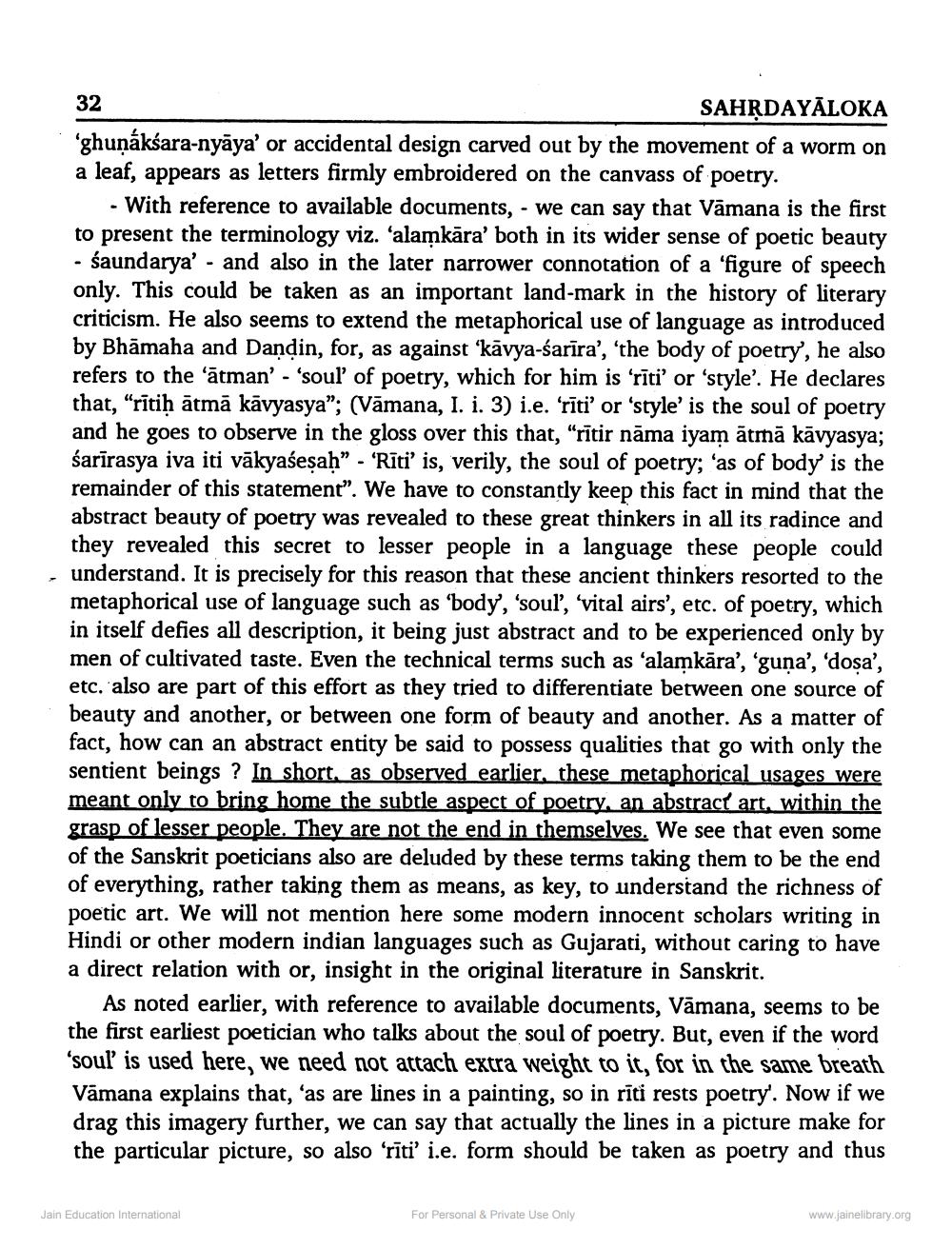________________
32
SAHRDAYĀLOKA ‘ghuņákśara-nyāya' or accidental design carved out by the movement of a worm on a leaf, appears as letters firmly embroidered on the canvass of poetry.
- With reference to available documents, - we can say that Vāmana is the first to present the terminology viz. ‘alamkāra' both in its wider sense of poetic beauty - śaundarya' - and also in the later narrower connotation of a 'figure of speech only. This could be taken as an important land-mark in the history of literary criticism. He also seems to extend the metaphorical use of language as introduced by Bhāmaha and Dandin, for, as against 'kāvya-śarīra', 'the body of poetry', he also refers to the 'ātman' - 'soul of poetry, which for him is ‘rīti' or 'style'. He declares that, "rītih ātmā kāvyasya”; (Vāmana, I. i. 3) i.e. 'rīti' or 'style' is the soul of poetry and he goes to observe in the gloss over this that, "rītir nāma iyam ātmā kāvyasya; śarīrasya iva iti vākyaśesah” - 'Rīti' is, verily, the soul of poetry; 'as of body is the remainder of this statement". We have to constantly keep this fact in mind that the abstract beauty of poetry was revealed to these great thinkers in all its radince and they revealed this secret to lesser people in a language these people could understand. It is precisely for this reason that these ancient thinkers resorted to the metaphorical use of language such as 'body', 'soul', 'vital airs', etc. of poetry, which
in itself defies all description, it being just abstract and to be experienced only by men of cultivated taste. Even the technical terms such as ‘alamkāra', 'guna', 'dosa', etc. also are part of this effort as they tried to differentiate between one source of beauty and another, or between one form of beauty and another. As a matter of fact, how can an abstract entity be said to possess qualities that go with only the sentient beings? In short, as observed earlier, these metaphorical usages were meant only to bring home the subtle aspect of poetry, an abstract art, within the grasp of lesser people. They are not the end in themselves. We see that even some of the Sanskrit poeticians also are deluded by these terms taking them to be the end of everything, rather taking them as means, as key, to understand the richness of poetic art. We will not mention here some modern innocent scholars writing in Hindi or other modern indian languages such as Gujarati, without caring to have a direct relation with or, insight in the original literature in Sanskrit.
As noted earlier, with reference to available documents, Vāmana, seems to be the first earliest poetician who talks about the soul of poetry. But, even if the word 'souľ is used here, we need not attach extra weight to it, for in the same breath Vāmana explains that, ‘as are lines in a painting, so in rīti rests poetry'. Now if we drag this imagery further, we can say that actually the lines in a picture make for the particular picture, so also ‘rīti' i.e. form should be taken as poetry and thus
Jain Education International
For Personal & Private Use Only
www.jainelibrary.org




